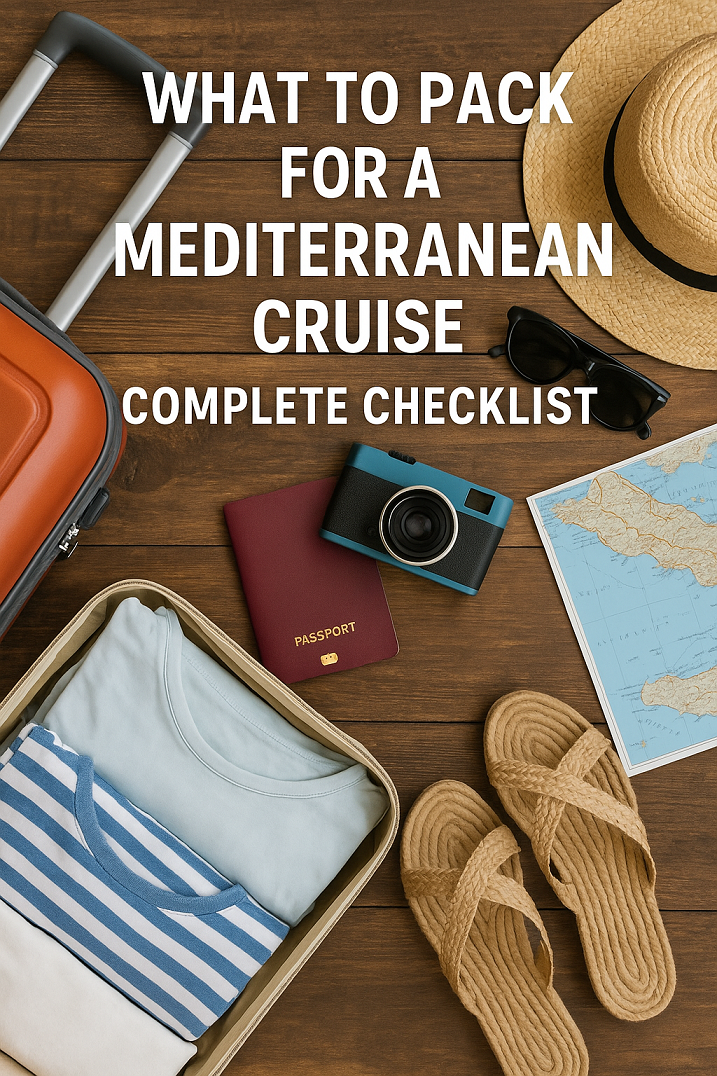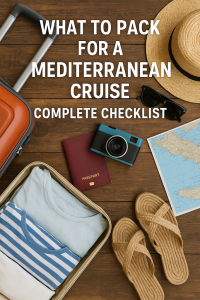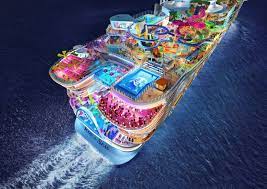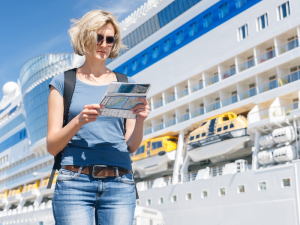Planning a Mediterranean cruise in 2025? This expert guide offers a complete packing checklist with smart tips tailored to warm climates, port excursions, and shipboard life—perfect for first-time and seasoned travelers alike.
Your 2025 Guide to Seamless Coastal Travel from Barcelona to the Aegean
Why Packing Right for a Mediterranean Cruise Matters
The Mediterranean isn’t just a cruise—it’s a journey across centuries of history, layered cultures, and climates that shift between sun-kissed islands and breezy coastal cities. With over 6.4 million cruise passengers recorded in the Mediterranean in 2024 alone (Cruise Lines International Association, CLIA), the region remains one of the world’s most beloved sailing destinations. But even experienced travelers can underestimate what to pack.
Unlike Caribbean cruises, the Mediterranean presents unique travel dynamics—frequent port calls, walking-intensive tours, strict dress codes in religious sites, and hot but modest coastal cultures in places like Italy, Greece, and Turkey. Understanding these nuances can make the difference between a smooth voyage and a stressful one.
The Essentials: Clothing & Footwear
Everyday Cruise Wear (Shipboard & Port Days)
A Mediterranean cruise generally runs warm—expect daytime highs between 24°C and 34°C (75°F to 93°F) from May through September. However, smart packing is about balance: lightweight doesn’t mean underprepared.
What to Pack ?
-
Light, breathable clothing (linen shirts, cotton dresses, flowy tops)
-
Smart casual evening wear for dinners (some cruise lines have dress codes)
-
Swimwear and cover-ups for the pool or beach
-
Walking shoes (think cobblestone streets in Dubrovnik or Santorini)
-
Light sweater or scarf for cool evenings or air-conditioned interiors
Real-World Tip:
Ports like Rome (Civitavecchia) or Athens (Piraeus) involve long bus rides to city centers—bring a daypack with layered clothing and snacks.
Dressing for Culture: Respectful Attire for Sacred Sites
Europe’s Mediterranean coastline is lined with religious and cultural landmarks—from Istanbul’s Blue Mosque to Sicily’s ancient cathedrals. Many sites enforce modest dress codes.
Modesty Essentials
-
Long skirt or trousers for women
-
Shawl or scarf for covering shoulders
-
Closed-toe shoes for uneven terrain or temple steps
Authority Insight:
The UNESCO World Heritage Centre emphasizes responsible tourism at cultural sites, urging travelers to dress respectfully to protect heritage value (UNESCO, 2023).
Weather Protection: Sun, Wind, and Sea
Mediterranean Climate Prep
Summer heat can be intense, particularly in July and August, when sunburn and dehydration are common risks. Meanwhile, windy days in ports like Mykonos or Naples call for a backup layer.
Don’t Forget
-
Wide-brimmed hat or cap
-
UV-protection sunglasses
-
Reef-safe sunscreen (required in some eco-zones like Croatia’s Blue Lagoon)
-
Reusable water bottle with filter (some cruise lines now ban single-use plastics)
Maritime Regulation Reference:
Under EU Directive 2019/904, cruise operators are limiting single-use plastics onboard. Passengers are encouraged to bring reusable items (European Commission).
Shore Excursion Packing: Smart Add-Ons
What to Bring Ashore
Ports in the Med are packed with adventure: cycling in Valencia, kayaking in Kotor, or food tours in Sicily. You’ll want gear that suits diverse activities.
Must-Haves for Shore Days
-
Backpack or tote bag (collapsible bags are a bonus)
-
Portable charger/power bank
-
Local currency (euros, Turkish lira, etc.—some places don’t accept cards)
-
Offline map app like Maps.me or Google Maps with downloaded city areas
Port-Specific Tip:
In Monte Carlo, some luxury shops refuse cards from non-EU banks. Bring a small amount of cash for souvenirs or entrance fees.
Shipboard Essentials: What People Forget
Onboard Necessities
Life onboard is relaxing—but it also means adapting to cruise etiquette and health protocols.
Pack These Smart Extras
-
Motion sickness bands or tablets (especially for smaller ships)
-
Lanyard or cardholder for your keycard (used for cabin access and payments)
-
Refillable toiletries (eco-friendly and space-saving)
-
Magnetic hooks (ship cabin walls are metal—add hanging storage!)
Real-World Application:
According to passenger reviews on CruiseCritic, magnetic hooks are one of the most recommended space-saving tools for cruise cabins under 20 sq. meters.
Travel Documents & Tech
Documentation Is Key
Smooth embarkation depends on organized paperwork—especially for ports in non-Schengen countries like Turkey, Palestine, or Montenegro.
Essential Documents
-
Passport (valid for at least 6 months beyond cruise date)
-
Cruise documents and itinerary printouts
-
Travel insurance policy (with cruise-specific coverage)
-
Health certificates (check COVID-19 updates on port health sites)
Digital Toolkit
-
Smartphone (with international SIM or eSIM)
-
Travel adapter (Mediterranean ships use EU plugs: 220V, type C or F)
-
Translation apps like Google Translate for menus or signs
Reference:
The International Maritime Health Association (IMHA) recommends carrying documentation of pre-existing medical conditions in case of emergency evacuation (IMHA, 2024).
Packing for Families or Groups
Multi-Generation Travel Tips
Mediterranean cruises are popular for families and reunions, but managing group needs takes planning.
Key Tips:
-
For children: Water shoes, games, collapsible strollers, and snacks for long excursions.
-
For elderly travelers: Compression socks for flights, medications in original packaging, and lightweight walking canes if needed.
-
For teens: eReaders, swimsuits, and access to social Wi-Fi plans (ask your cruise provider).
Packing Light vs. Packing Smart
Is It Better to Pack Carry-On Only?
Airlines flying into embarkation ports like Barcelona, Rome, or Athens often enforce tight baggage limits. Many travellers now opt for carry-on only—but that requires skillful packing.
Pros:
-
Avoid lost luggage
-
Faster disembarkation and transfers
Cons:
-
Limited outfit variety
-
Cruise dress codes may require extra attire
Case Study:
A 2024 travel survey by S&P Global Travel Insights showed 42% of Mediterranean cruisers pack two outfits per day due to diverse port activities and shipboard events.
Cruise-Specific Considerations for 2025
Latest Trends and What They Mean for Your Luggage
In the last 3–5 years, Mediterranean cruises have embraced:
-
Sustainability: Pack reusable water bottles, reef-safe toiletries.
-
Hybrid shore excursions: Some ports require special gear (e.g., hiking poles for Mount Etna).
-
Digital experiences: QR menus, app-based bookings, and self-guided tour apps are common.
FAQs
1. Do I need formal wear for a Mediterranean cruise?
Some cruise lines require formal wear for “Captain’s Night” or special dinners. A smart dress or suit will usually suffice.
2. Will I need euros in every port?
Most Mediterranean ports use euros, but destinations like Turkey and Croatia use local currencies. Bring small bills and check exchange options.
3. Can I do laundry onboard?
Yes, many ships offer self-service laundromats or paid services. Check your ship’s amenities.
4. Are there dress codes for religious sites?
Yes, especially in countries like Greece, Turkey, and Palestine. Shoulders and knees should be covered.
5. What’s the weather like on a Mediterranean cruise?
Expect warm, dry weather from late spring to early autumn. Pack for sun protection and light rain showers.
6. Is seasickness common in the Mediterranean?
It’s usually minimal due to calm seas, but it depends on the season and vessel size.
7. Should I bring snorkeling gear?
If you’re planning water excursions, yes—but many tours offer gear rental.
Conclusion: Cruise Confidently with a Smartly Packed Bag
A Mediterranean cruise can be one of the most memorable trips of your life—if you pack with both comfort and cultural awareness in mind. From smart sun protection to respectful attire, from plug adapters to magnetic hooks, every item serves a purpose when you’re moving between countries, cultures, and climates.
Let your suitcase reflect the journey: organized, purposeful, and ready for anything. Whether you’re sailing solo or with a full family reunion, this checklist helps you navigate smoothly—onboard and ashore.
Ready to sail? Pack light, travel far, and cruise smart.
References
-
Cruise Lines International Association. (2024). CLIA Global Cruise Trends Report. https://cruising.org
-
UNESCO. (2023). Responsible Tourism Guidelines. https://whc.unesco.org
-
European Commission. (2022). Directive (EU) 2019/904 on the Reduction of the Impact of Certain Plastic Products on the Environment. https://ec.europa.eu
-
International Maritime Health Association. (2024). Cruise Health Safety Recommendations. https://www.imha.net
-
S&P Global Travel Insights. (2024). Mediterranean Cruise Passenger Behavior Survey. https://www.spglobal.com
-
CruiseCritic. (2024). User-Generated Cruise Reviews and Cabin Tips. https://www.cruisecritic.com






